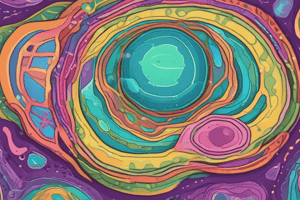Podcast
Questions and Answers
Quelle est la fonction principale des mitochondries dans une cellule?
Quelle est la fonction principale des mitochondries dans une cellule?
- Stocker des lipides
- Synthétiser des protéines
- Produire de l'énergie (correct)
- Décomposer les déchets cellulaires
Quel type de cellule ne contient pas de mitochondries?
Quel type de cellule ne contient pas de mitochondries?
- Cellules musculaires
- Globules rouges (correct)
- Cellules épithéliales
- Cellules nerveuses
Quelles sont les principales composantes de la membrane interne des mitochondries?
Quelles sont les principales composantes de la membrane interne des mitochondries?
- Minéraux et vitamines
- Protéines et lipides (correct)
- Glucides complexes
- Acides nucléiques
Quel rôle les protons H+ jouent-ils dans l'espace intermembranaire des mitochondries?
Quel rôle les protons H+ jouent-ils dans l'espace intermembranaire des mitochondries?
Quel est le diamètre des pores présents dans la membrane externe des mitochondries?
Quel est le diamètre des pores présents dans la membrane externe des mitochondries?
Quel type d'ADN est présent dans la matrice mitochondriale?
Quel type d'ADN est présent dans la matrice mitochondriale?
Les crêtes mitochondriales sont responsables de quelle fonction?
Les crêtes mitochondriales sont responsables de quelle fonction?
Quelle est la composition lipidique de la membrane externe des mitochondries?
Quelle est la composition lipidique de la membrane externe des mitochondries?
Flashcards
Mitochondria
Mitochondria
Double-membrane organelles found in all eukaryotic cells (except red blood cells), producing energy and containing their own DNA.
Mitochondrial DNA (mtDNA)
Mitochondrial DNA (mtDNA)
Circular DNA located within the mitochondria's matrix; codes for some mitochondrial proteins.
Mitochondrial Membrane
Mitochondrial Membrane
The double membrane system of mitochondria, with the outer membrane being permeable and the inner membrane being highly folded and impermeable for active transport
Outer Mitochondrial Membrane
Outer Mitochondrial Membrane
Signup and view all the flashcards
Inner Mitochondrial Membrane
Inner Mitochondrial Membrane
Signup and view all the flashcards
Cristae
Cristae
Signup and view all the flashcards
Mitochondrial Matrix
Mitochondrial Matrix
Signup and view all the flashcards
Chondriome
Chondriome
Signup and view all the flashcards
Study Notes
Mitochondria Characteristics
- Organelles found in eukaryotic cells, absent in prokaryotic cells (e.g., red blood cells)
- Present in all cell types, except red blood cells, with numbers varying depending on cellular function (1000-3000 per cell)
- Have a double membrane
- Possess their own genome (separate from the cell's nucleus)
- Are involved in energy production (ATP)
- Exhibit diverse morphologies (shapes and sizes) in different cell types (spherical, filamentous)
- Move within cells due to interactions with the cytoskeleton
Mitochondrial Structure
- Outer membrane: Smooth and continuous, similar in composition to the cell membrane, containing 5-7nm lipid bilayer with 50-60% proteins and 40-50% lipids, enriched in porins (2-3nm diameter pores), permeable to small molecules (molecular weight < 10 kDa)
- Intermembrane space: Narrow space between the outer and inner membranes
- Inner membrane: Folded to form cristae, with a 5-6nm lipid bilayer, highly impermeable to ions, containing proteins that catalyze ATP production, rich in cardiolipin.
- Matrix: Innermost compartment of the mitochondrion, containing mitochondrial DNA (mtDNA), ribosomes (mitoribosomes), and enzymes involved in the Krebs cycle (citric acid cycle) and fatty acid oxidation.
Mitochondrial Matrix
- Contains a granular material.
- Granules contain mitochondrial ribosomes (similar to bacterial ribosomes), circular DNA (mtDNA), messenger RNA (mRNA), and transfer RNA (tRNA)
- Contains enzymes for the Krebs cycle, pyruvate oxidation, and fatty acid oxidation.
Studying That Suits You
Use AI to generate personalized quizzes and flashcards to suit your learning preferences.
Related Documents
Description
Ce quiz explore les caractéristiques et la structure des mitochondries, organites essentiels aux cellules eucaryotes. Vous apprendrez leur rôle dans la production d'énergie et leur morphologie variée. Testez vos connaissances sur ces composants cellulaires clés !




